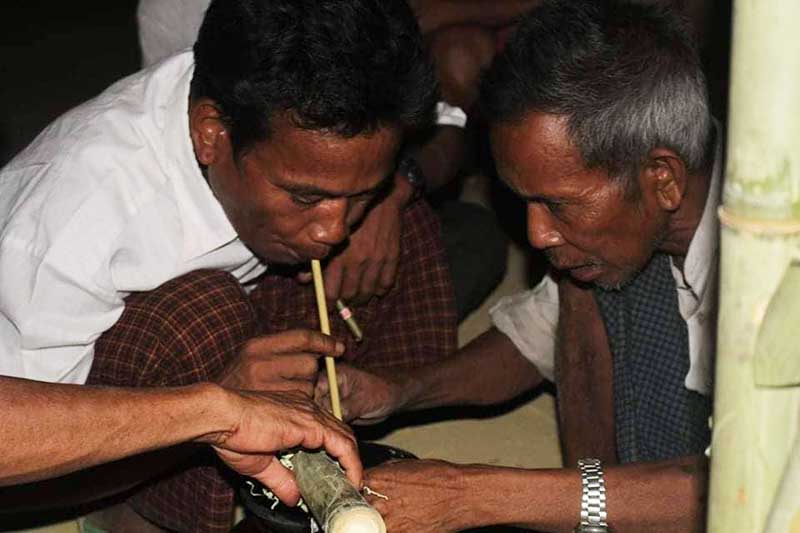- Junta unable to hold elections in dozens of wards and village-tracts in Sittwe, Kyaukphyu
- Fighting escalates between Myanmar military, Arakan Army in Ayeyarwady Region
- Regime steps up civilian arrests in Sittwe
- ULA safeguards Mrauk-U's ancient heritage
- Arakan on the Edge: What the DMG Landmine Impact Report Reveals About Myanmar's Deepening Humanitarian Crisis
Mro Ethnic Group’s Ritual Slaughter Carries On Among Some
On the second day of the ritual slaughter, villagers must go up the hill to cut bamboo to build a traditional platform. The villagers use the bamboo they have to cut to build a traditional platform attached to the host’s home.
21 Jul 2022

Written by Min Tun
In Vann Vi village, part of Arakan State’s Ponnagyun Township, the Mro people have been preparing for an ancient ritual slaughter.
The village is home to some 400 ethnic Mro people, who belong to one of the oldest tribes in western Myanmar. Long ago, Mro people were animists and practiced folk religion. Today, the majority are Buddhist, with a smaller population being Christians.
Mro people who practise Buddhism still maintain the tribal ritual of offering a sacrificial bull to their traditional nat, or guardian spirit.
Usually, the ritual is performed on the occasion of a house-warming ceremony; ear-piercing for young girls; wedding receptions; or when someone is sick. Or, when an expecting couple want a baby boy.

Recently, a woman from Vann Vi village fell ill, and villagers were preparing to perform the ritual slaughter to offer a sacrificial bull to the guardian spirit, who is traditionally believed to protect the farmlands of the Mro people.
“It is our tradition. And I gave a hand because it is our ritual. Everyone in the village helps in this ritual,” said U Aung Htwee, with pride.
Together with his fellow male villagers, U Aung Htwee cut down bamboo from a nearby mountainside. They then built a platform attached to the house of the sick woman. The fact that they were working together to perform ritual highlights of their respect for tradition and unity among tribal people stood out, for some at least.
“We perform this ritual according to our faith. It is a tradition handed down from our ancestors,” said chairman U Zani Phyu of the Mro Literature and Culture Association.
Mro people believe the ritual promotes the health and wealth of families. The ritual can be performed at any time, regardless of weather and time. Normally, the ritual is performed for three days, to the accompaniment of traditional dance and music.
On the eve of the ritual, a room is prepared at the house where the ritual will be held. Then, a pig is slaughtered in the house, and offered to the guardian spirit of the home.
The slain pig’s ears are then cut off, tied with string, and worn by family members as a safeguard.

On the second day of the ritual slaughter, villagers must go up the hill to cut bamboo to build a traditional platform. The villagers use the bamboo they have to cut to build a traditional platform attached to the host’s home.
Then a wreath is erected in the middle of the village to tie an ox to. That evening, Mro traditional dance troupes play traditional instruments and dance all night long around a wreath tied to a cow.
On the third day, the tied ox is slaughtered with a spear and taken to a traditional mausoleum built in the host’s home, where it is cooked according to Mro tradition and served to the gathered mourners/celebrants.
But the Mro tribe’s ritual slaughter, which has been celebrated for generations, has not been widely held for more than a decade due to poverty and regional instability, according to the Mro Literature and Culture Association.

“Now the traditional ritual slaughter is being celebrated again. People also want to have this festival to preserve the tradition. This event is our cultural heritage and cannot be lost,” said U Zani Phyu, chairman of the Mro Literature and Culture Association.
“According to records, the Mro people are one of the oldest people living in Arakan State,” he added. “The Mro ethnic group lives in the Yoe Chaung area of Kyauktaw Township, Sanpadi Chaung area of Ponnagyun Township, and Buthidaung and Maungdaw townships of Arakan State.”
The Mro tribe, with a population of only tens of thousands, is mainly engaged in farming and agriculture. Due to the Mro ethnic people often living in remote, mountainous areas, their access to education and employment is limited, and knowledge of the outside world remains low.
The Mro people also have their own language, literature and traditional music. The traditional ritual slaughter is just one of many Mro cultural traditions.

Ko Maung Ni Tun, a Mro resident of Ponnagyun Township, said the traditional ritual slaughter is fading, and needs to be systematically maintained.
“The traditional ritual slaughter is our tradition. We must preserve these traditional practices,” he said.
Nonetheless, U Aung Htwe, an ethnic Mro man, is pleased that a traditional heritage event is still being celebrated, even if on a limited scale.
“At first, I was worried that one of my traditions would disappear,” he said. “Over the years, we have gradually preserved our tradition, and now I enjoy dancing with adults as much as I did before.”




9 M.jpg)


.png)









